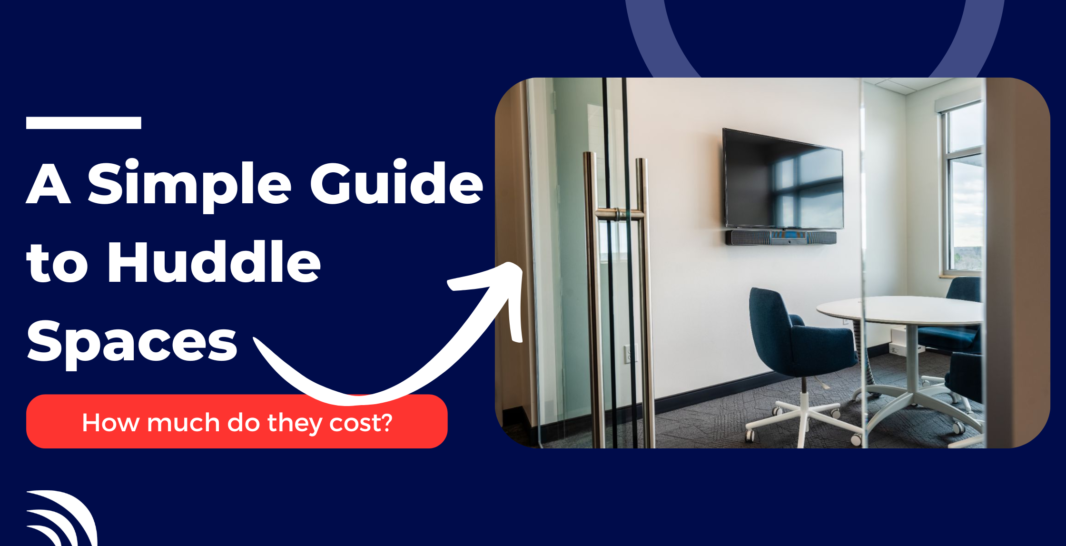A Simple Guide to Huddle Spaces – How Much Do They Cost?
Huddle spaces have become an integral part of modern workplaces, facilitating collaboration and productivity among small teams. These compact meeting rooms, designed to accommodate 4-6 people, are equipped with audio-visual (AV) technology that enables seamless communication and content sharing.
What is a Huddle Space?
A huddle space is a small, enclosed area within an office designed for impromptu meetings, brainstorming sessions, and focused discussions among team members. These spaces are typically outfitted with a display or interactive whiteboard, video conferencing capabilities, and collaboration tools, allowing for efficient and engaging meetings, both in-person and remotely.
Why Have Huddle Spaces Gained Popularity?
The rise of huddle spaces can be attributed to several aspects.
Increased Demand for Collaboration: In today’s fast-paced business environment, effective collaboration is crucial for success. Huddle spaces provide a dedicated space for teams to come together, share ideas, and work on projects in a distraction-free environment.
Remote and Hybrid Work: With the growing trend of remote and hybrid work arrangements, huddle spaces facilitate seamless communication and collaboration between on-site and remote team members through video conferencing and content sharing capabilities.
Efficient Use of Space: Huddle spaces optimize the use of office space by providing compact meeting areas, eliminating the need for larger, underutilized conference rooms.
Flexibility and Agility: These spaces offer flexibility and agility, allowing teams to quickly gather and engage in productive discussions without the need for extensive scheduling or setup.
Technical Considerations for Huddle Spaces
When designing a huddle space, several technical aspects should be considered to ensure an optimal collaboration experience.
Display or Interactive Whiteboard: A high-quality display or interactive whiteboard is essential for content sharing, presentations, and virtual collaboration. Typical costs range from $1,000 to $5,000, depending on size and features.
Video Conferencing System: A reliable video conferencing system, including a camera, microphone, and speaker, is crucial for remote collaboration. Costs can range from $500 to $3,000, depending on the quality and features required.
Collaboration Software: Huddle spaces often incorporate collaboration software or applications that facilitate content sharing, annotation, and real-time editing. Costs vary based on the software chosen and the number of licenses required.
Connectivity and Cabling: Ensuring seamless connectivity and proper cabling is essential for a smooth huddle space experience. Costs can range from $500 to $2,000, depending on the complexity of the setup.
Furniture and Acoustics: Comfortable and ergonomic furniture, as well as proper acoustic treatment, can enhance the overall experience in a huddle space. Costs can range from $2,000 to $10,000, depending on the quality and quantity of furniture and acoustic materials used.
Ballpark Costs for a Huddle Space
The overall cost of a huddle space can vary significantly based on the specific requirements, quality of components, and the level of integration desired. However, a typical huddle space setup can range from $5,000 to $20,000, with higher-end solutions potentially exceeding $30,000.
It’s important to note that these costs are approximate and can fluctuate based on factors such as the size of the space, the number of huddle spaces required, and any additional customizations or integrations needed.
Investing in well-designed huddle spaces can significantly enhance collaboration, productivity, and overall employee satisfaction within an organization. By carefully considering the technical requirements and budgeting accordingly, enterprises can create effective and engaging huddle spaces that meet their specific needs.
Determining Your Huddle Space Needs and Working with an Integrator
Before embarking on the journey of creating a huddle space, it’s essential to carefully assess your organization’s specific needs and requirements. This process will ensure that the huddle space is tailored to your team’s collaboration style and workflow, maximizing its effectiveness and return on investment.
Step 1: Assessing Your Huddle Space Needs
Start by evaluating the following aspects of your space and needs.
Team Size and Collaboration Style: Consider the typical size of your teams and their preferred collaboration methods. Do they primarily work in-person, remotely, or a combination of both?
Meeting Frequency and Duration: Determine the frequency and duration of meetings that will take place in the huddle space. This will help you choose the appropriate size and layout.
Content Sharing and Presentation Needs: Identify the types of content your teams need to share during meetings, such as presentations, documents, or video conferencing.
Connectivity and Integration Requirements: Assess the need for integrating the huddle space with existing collaboration tools, video conferencing platforms, or other software solutions used within your organization.
Accessibility and Inclusivity: Consider any accessibility requirements or accommodations needed to ensure the huddle space is inclusive and usable for all team members.
Step 2: Partnering with an AV Integrator like VIcom
Once you have a clear understanding of your needs, it’s time to partner with an experienced AV integrator like VIcom. An integrator will work closely with you to engineer the right solution, ensuring seamless integration of all components and a smooth implementation process.
Here’s how we can assist you:
Solution Design: The integrator will leverage their expertise to design a huddle space solution that meets your specific requirements, taking into account factors such as room size, acoustics, and technology needs.
Component Selection: They will recommend and source the appropriate AV components, including displays, video conferencing systems, collaboration software, and any necessary cabling or connectivity solutions.
Integration and Installation: The integrator will handle the installation and integration of all components, ensuring a cohesive and seamless experience within the huddle space.
Collaboration with Other Stakeholders: If your huddle space project involves other stakeholders, such as architects, designers, or IT teams, the integrator will coordinate and collaborate with them to ensure a successful implementation.
Step 3: Ongoing Support and Training
To maximize the value of your huddle space investment, it’s crucial to have ongoing support and training in place. VIcom offers comprehensive support plans to ensure that your huddle space remains fully operational and that users are equipped with the knowledge to utilize it effectively.
User Training: VIcom can provide training sessions to ensure that your team members are proficient in using the huddle space technology, maximizing its capabilities and enhancing collaboration.
Maintenance and Support: Regular maintenance and support services from VIcom will help identify and address any issues promptly, minimizing downtime and ensuring the huddle space remains in optimal condition.
Software Updates and Upgrades: As technology evolves, VIcom can assist with software updates and upgrades, ensuring that your huddle space stays up-to-date and compatible with the latest collaboration tools and platforms.
If you’re interested in a huddle space for your organization, please fill out the form below to schedule a free consultation!

